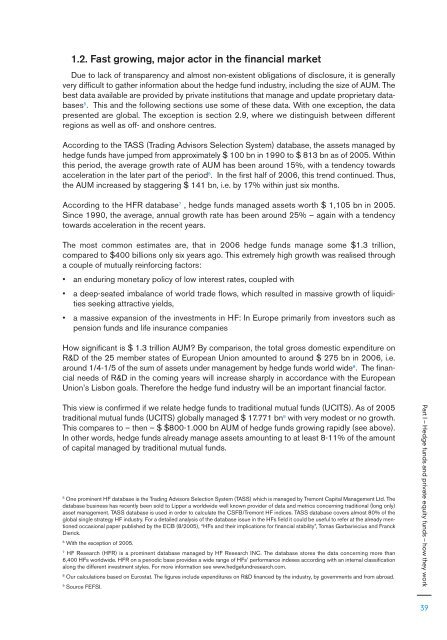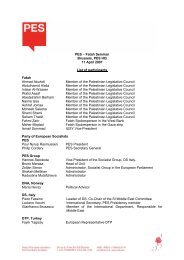Hedge funds and Private Equity - PES
Hedge funds and Private Equity - PES
Hedge funds and Private Equity - PES
You also want an ePaper? Increase the reach of your titles
YUMPU automatically turns print PDFs into web optimized ePapers that Google loves.
1.2. Fast growing, major actor in the financial market<br />
Due to lack of transparency <strong>and</strong> almost non-existent obligations of disclosure, it is generally<br />
very difficult to gather information about the hedge fund industry, including the size of AUM. The<br />
best data available are provided by private institutions that manage <strong>and</strong> update proprietary databases<br />
5 . This <strong>and</strong> the following sections use some of these data. With one exception, the data<br />
presented are global. The exception is section 2.9, where we distinguish between different<br />
regions as well as off- <strong>and</strong> onshore centres.<br />
According to the TASS (Trading Advisors Selection System) database, the assets managed by<br />
hedge <strong>funds</strong> have jumped from approximately $ 100 bn in 1990 to $ 813 bn as of 2005. Within<br />
this period, the average growth rate of AUM has been around 15%, with a tendency towards<br />
acceleration in the later part of the period 6 . In the first half of 2006, this trend continued. Thus,<br />
the AUM increased by staggering $ 141 bn, i.e. by 17% within just six months.<br />
According to the HFR database 7 , hedge <strong>funds</strong> managed assets worth $ 1,105 bn in 2005.<br />
Since 1990, the average, annual growth rate has been around 25% – again with a tendency<br />
towards acceleration in the recent years.<br />
The most common estimates are, that in 2006 hedge <strong>funds</strong> manage some $1.3 trillion,<br />
compared to $400 billions only six years ago. This extremely high growth was realised through<br />
a couple of mutually reinforcing factors:<br />
an enduring monetary policy of low interest rates, coupled with<br />
a deep-seated imbalance of world trade flows, which resulted in massive growth of liquidities<br />
seeking attractive yields,<br />
a massive expansion of the investments in HF: In Europe primarily from investors such as<br />
pension <strong>funds</strong> <strong>and</strong> life insurance companies<br />
How significant is $ 1.3 trillion AUM? By comparison, the total gross domestic expenditure on<br />
R&D of the 25 member states of European Union amounted to around $ 275 bn in 2006, i.e.<br />
around 1/4-1/5 of the sum of assets under management by hedge <strong>funds</strong> world wide 8 . The financial<br />
needs of R&D in the coming years will increase sharply in accordance with the European<br />
Union’s Lisbon goals. Therefore the hedge fund industry will be an important financial factor.<br />
This view is confirmed if we relate hedge <strong>funds</strong> to traditional mutual <strong>funds</strong> (UCITS). As of 2005<br />
traditional mutual <strong>funds</strong> (UCITS) globally managed $ 17.771 bn 9 with very modest or no growth.<br />
This compares to – then – $ $800-1.000 bn AUM of hedge <strong>funds</strong> growing rapidly (see above).<br />
In other words, hedge <strong>funds</strong> already manage assets amounting to at least 8-11% of the amount<br />
of capital managed by traditional mutual <strong>funds</strong>.<br />
5 One prominent HF database is the Trading Advisors Selection System (TASS) which is managed by Tremont Capital Management Ltd. The<br />
database business has recently been sold to Lipper a worldwide well known provider of data <strong>and</strong> metrics concerning traditional (long only)<br />
asset management. TASS database is used in order to calculate the CSFB/Tremont HF indices. TASS database covers almost 80% of the<br />
global single strategy HF industry. For a detailed analysis of the database issue in the HFs field it could be useful to refer at the already mentioned<br />
occasional paper published by the ECB (8/2005), “HFs <strong>and</strong> their implications for financial stability”, Tomas Garbarivicius <strong>and</strong> Franck<br />
Dierick.<br />
6 With the exception of 2005.<br />
7 HF Research (HFR) is a prominent database managed by HF Research INC. The database stores the data concerning more than<br />
6,400 HFs worldwide. HFR on a periodic base provides a wide range of HFs’ performance indexes according with an internal classification<br />
along the different investment styles. For more information see www.hedgefundresearch.com.<br />
8 Our calculations based on Eurostat. The figures include expenditures on R&D financed by the industry, by governments <strong>and</strong> from abroad.<br />
9 Source FEFSI.<br />
Part I – <strong>Hedge</strong> <strong>funds</strong> <strong>and</strong> private equity <strong>funds</strong> – how they work<br />
39




